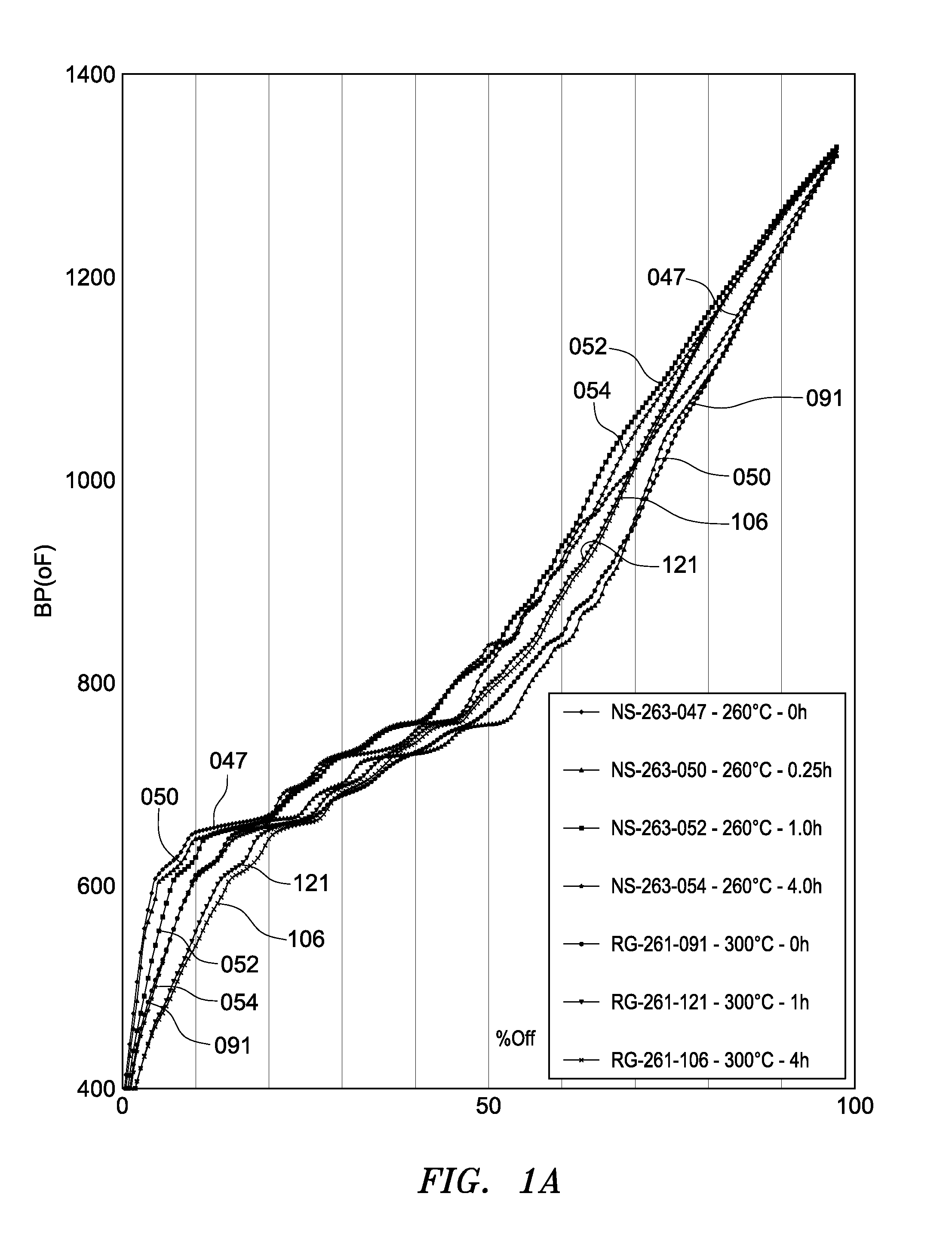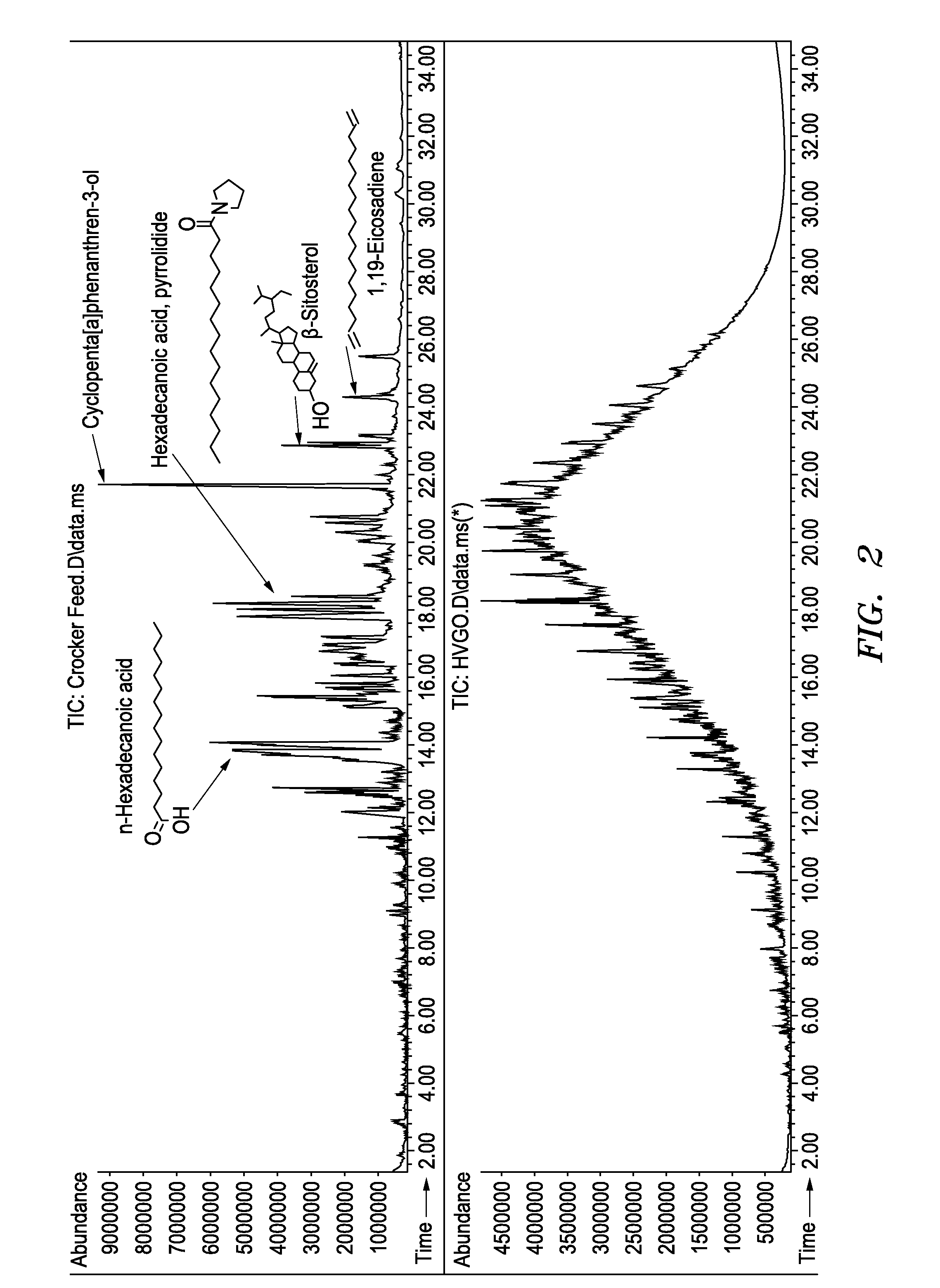Compositions of matter comprising extracted algae oil
a technology of algae oil and composition, applied in the field of compositions, can solve the problems of insufficient characterization and understanding of the characterization and the and is incompatible with the equipment and process scheme of high-triglyceride and/or high hetero-atom containing oils
- Summary
- Abstract
- Description
- Claims
- Application Information
AI Technical Summary
Benefits of technology
Problems solved by technology
Method used
Image
Examples
example i
[0154]Several ASTM D7169 boiling point (BP) curves for crude algae oil embodiments are shown in FIG. 1A, and the BP distributions are summarized in FIG. 1B and Table 1A and Table 1B. These boiling point curves are generally representative of many “full-boiling range” algae oils according to the disclosure, wherein “full-boiling range” algae oils means the algae oil is the entire oleaginous composition obtained in extraction step (j) above, rather than a fraction thereof. Table 1A and Table 1B are shown below.
TABLE 1AHoldingFraction Mass PercenttimeInitial-Sample ID(hours)260° F.260-400° F.400-490° F.290-630° F.630-1020° F.>1020° F.260° C.NS-263-047000.51.56.562.029.5NS-263-0500.2501.01.37.163.826.8NS-263-052101.22.27.355.833.5NS-263-054401.53.09.554.131.9300° C.RG-261-091001.32.928.042.025.8RG-261-121102.44.423.540.029.7RG-261-106402.25.024.539.229.1
TABLE 1BHoldingtimeCut point Mass PercentSample ID(hours)260° F.400° F.490° F.630° F.1020° F.>1020° F.260° C.NS-263-047000.52.08.570.52...
example ii
[0158]A GC fingerprint, and detailed compositional information, of another embodiment of the algae oil composition of matter are shown in FIG. 2. Algae oil was extracted from Nannochloropsis according to the above-listed hydrothermal treatment and solvent extraction steps. FIG. 2 compares this crude algae oil (top panel) to a HT GC-MS fingerprint and detailed compositional information of a HVGO fraction of a fossil petroleum crude (bottom panel). Table 2A, Table 2B, and Table 2C are shown below. Table 2A shows compound classes of the exemplary algae oil. Table 2B compares EA data of the exemplary algae oil to that of the heavy VGO. Table 2C shows compositional analysis of the heavy VGO.
TABLE 2Aalgae oil (%)saturates1.7olefins9.5aromatics1.3fatty acids26.1amides10.9N-aromatics2.7oxygenates7.9sterols9.1
TABLE 2Balgal oilheavy VGOwt % Carbon78.286wt % Hydrogen10.610.7wt % Nitrogen4.1wt % Oxygen6.4wt % Sulfur2.3H / C ratio1.631.49
TABLE 2CHVGO (%)saturates23.2monoaromatics19.0diaromatics22....
example iii
[0161]Additional embodiments of the novel algae oils are described in Table 3A and Table 3D and in FIG. 4-FIG. 12. Table 3A and Table 3D list compositional and elemental analysis, by HT-GC-MS, of the additional algae oil embodiments. These algae oils were produced from various algae strains, specifically Nannochloropsis, Scenedesmus, Spirulina, and Dunaliella, and extracted by hydrothermal methods according to extraction steps (a)-(j) disclosed above. Step (b) of the extraction was performed using 30 minutes holding time at 300 degrees C, and steps f-j were performed with mixed heptanes solvent in some embodiments and MIBK solvent in other embodiments, as is apparent from the tables and figures. Table 3A, Table 3B. Table 3C. and Table 3D are provided below. Table 3B and Table 3C are described further below.
saturatedunsaturatednitrogenalgae strainhydrocarbonshydrocarbonsaromaticscompoundsnitrilesHeptanesSpirulina5.52.62.58.60.7Dunaliella1.25.83.78.10.0Scenedesmus3.09.92.54.20.0Nannoc...
PUM
| Property | Measurement | Unit |
|---|---|---|
| Temperature | aaaaa | aaaaa |
| Temperature | aaaaa | aaaaa |
| Percent by mass | aaaaa | aaaaa |
Abstract
Description
Claims
Application Information
 Login to View More
Login to View More - R&D
- Intellectual Property
- Life Sciences
- Materials
- Tech Scout
- Unparalleled Data Quality
- Higher Quality Content
- 60% Fewer Hallucinations
Browse by: Latest US Patents, China's latest patents, Technical Efficacy Thesaurus, Application Domain, Technology Topic, Popular Technical Reports.
© 2025 PatSnap. All rights reserved.Legal|Privacy policy|Modern Slavery Act Transparency Statement|Sitemap|About US| Contact US: help@patsnap.com



